Virtual Production Techniques in Stop Motion Animation
Woodland set of Seaglass (2023)
Virtual production is a filmmaking technique that has found strength in productions such as The Mandalorian, 1899 and Poor Things - combining physical and virtual filmmaking techniques to create cutting-edge media. The use of large LED walls allow film making teams to utilise real time rendering game engines to create photorealistic sets as well as being able to control camera angles and depth of perspective without moving a whole set. An opportunity to explore some of these concepts arose as part of my MA in Animation at University of Salford, and I was curious to see what could be possible in my stop motion short film Seaglass (2023).
Flickering is a common concern amongst stop motion animators - the effect is created by tiny changes in lighting environments almost imperceptible to the naked eye. It's only when you play frames alongside each other that the nuances of lighting and shadows can be seen and it creates a distraction to the eye that can be tricky to control - particularly if the puppet animation is tricky requiring lengthy amounts of time to complete a single frame.
This was my main concern with using an LED screen in Seaglass for the backgrounds and time was taken to test the effects that could be seen - but none were immediately visible. A 70 inch screen was made available to use throughout the production of Seaglass and its influence became pivotal in the saturated looks achieved in the film.


Source images taken on location, North Devon
Seaglass was heavily influenced by the North Devon coastline and following a location trip in February 2023 to collect materials, images and video for inclusion in the film, I had a large amount of source materials to play with. Initially, I considered traditional methods such as painting or printing photographic backgrounds. Green screen was also considered but the use of felted assets and sets would have impacted post production time significantly with many stray fibres needing to be masked around in compositing across nearly all shots.
As the original images sometimes lacked the contrast required, all images required editing in Photoshop. As well as adjusting brightness/contrast levels, shots were blurred to varying degrees to increase the sense of depth. Some images worked better than others; and in some cases such as the portrait photo of woodland above, AI was made use of to generatively fill the image out to make use of the full width of the screen for wide shots. Ethically, this initially made me uncomfortable - however, with all source images being my own, using AI as a tool allowed me to create a world for Seaglass that was removed enough from the real world to not be a site-specific piece, therefore creating a unique world environment that best served the story.
Using the screen allowed for fast changes to be made in the studio, with immediate feedback though the camera ultimately allowing for the best set up possible. Time was taken to ensure that every detail of the background was looked after in just the same way as the props and puppets had been carefully created. This would have taken far more time and money if I had painted or printed my backgrounds. I doubt I'd have been able to produce a result with as much vibrancy and convincing depth on the budget I had available to me.
Test shot of the screen and woodland set
Framing shots using the LED screen was easier as the screen could be moved allowing for increased precision of the placement of the backgrounds and for a wider range of shots to be created from the same sets. For instance, the woodland set required shots from a variety of positions and the ease of moving the screen allowed for swift changes in set up. The screen also acts as a light source and combining this with the felt on the sets allowed for the soft but colourful looks I was seeking. Careful consideration of this would be needed with different materials and for different types of world environments.
From this experience, I believe there is significant potential for stop motion to create engaging worlds through the use of virtual production - not only from the photorealistic options explore here, but also in creating unique world environments utilising game engine technology such as Unreal.
Using the screen with the rotating coastal set
Still from Seaglass (2023)





